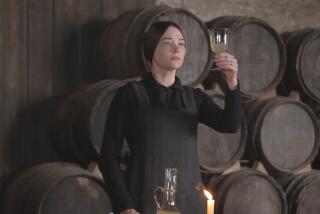STYLE : DESIGN : Fantasy in a Bottle
- Share via
Form follows fragrance. Or so they say in the perfume trade, perhaps the only business in which packaging--especially the bottle--can cost more than the product itself. No mere containers, perfume bottles must embody allure. The Parisian couturiers who concocted the first designer fragrances early in this century knew this and put their scents in opulent bottles produced by glassworks de luxe such as Baccarat and Lalique. Rene Lalique and others (including artists Fernand Leger, Salvador Dali and Man Ray) created striking bottles that are prized by collectors. And, as with Coca-Cola’s classic bottle, long-established fragrances such as Chanel No. 5 have become design icons with global appeal.
Like runway models, fragrance bottles strike a range of poses--formal, frivolous, sexy, elegant, playful. They strut their stuff in an increasingly crowded market: About 800 fragrances compete for a share of the $4.8-billion perfume industry. So launching a new fragrance is a high-stakes game in which fragrance, name, bottle, packaging and promotion must work together to create a distinctive image. “The bottle is the silent salesman of the fragrance,” says Marc Rosen, who has designed award-winning bottles for Elizabeth Arden (Red Door), Perry Ellis (360) and Karl Lagerfeld (KL), and teaches fragrance packaging design at New York’s Pratt Institute. “It has to stand out and have visual and tactile appeal. It should make you want to pick it up.”
“Name” designers usually rely on bottle designers to translate their ideas within technical and economic constraints. The shape of the bottle progresses from initial sketches to clay, wax or acrylic models until it’s ready for the glassmaker’s mold. Most bottles for fine perfumes are still manufactured at historic French glassworks such as Pochet and Brosse, where they’ve been produced since the 18th and 19th centuries, respectively. But no matter where they’re made or how delicate they appear, today’s bottles must be able to hold a fluid more volatile than cognac and withstand air shipment, rough handling and a Sweden-to-Saudi Arabia temperature range.
Mary Scott of Maddocks & Company in Los Angeles, designer of Giorgio’s Wings, observes: “Perfume is about fantasy and feeling good, and the bottle is an essential part of the experience.” Bottle designers generally work more from the concept description than the actual fragrance (which may still be in development). “Many times, you start with no name--the bottle may inspire one,” Scott says. That happened when Pierre Dinand of Paris, the godfather of fragrance bottle design, based a bottle for Yves Saint Laurent on Japanese inro , small boxes sometimes used to contain opium--which became the name of a best-selling fragrance. Since then, Dinand has created bottles for Calvin Klein’s Obsession, Eternity and Escape, Fendi, Tiffany and, new this spring, Adrienne Vittadini’s AV.
Bottles can be inspired by nature, fashion, architecture, the human body--almost anything. As she sketched the Wings bottle, Scott remembered a seedpod her mother kept in a drawer. The stopper of Dinand’s bottle for Givenchy’s Amarige is based on the pleated collar of a Givenchy gown. Tamotsu Yagi merged the forms of an egg and a test tube in his bottle for Benetton’s Tribu (on display in the new San Francisco Museum of Modern Art). And when defense lawyer Robert Shapiro presented helix-shaped bottles of Bijan’s DNA to reporters covering the O.J. Simpson trial, he probably didn’t know that the initials also stand for the names of Bijan’s children, Daniela, Nicolas and Alexandra.
Given the cluttered market and increasingly fickle consumers, most new fragrances don’t survive more than a couple of years. “Every year, it’s harder to do something new and unexpected,” Scott says. Still, she expects to see more innovative and complex designs, as well as simpler bottles geared to both men and women, such as Calvin Klein’s CK One cologne flask. Sculptor Stephan Weiss, husband and business partner of Donna Karan, created sinuous forms for her women’s and men’s fragrance bottles. “I treat the bottles as miniature sculptures--it’s the same process on a smaller scale,” he says. “At first, the manufacturers said, ‘No way,’ then they rose to the challenge.” Rosen notes: “Designers are pushing manufacturers, and they’re responding with new materials, textures and colors, while computerized production is bringing prices down. Almost anything can be created today.”






